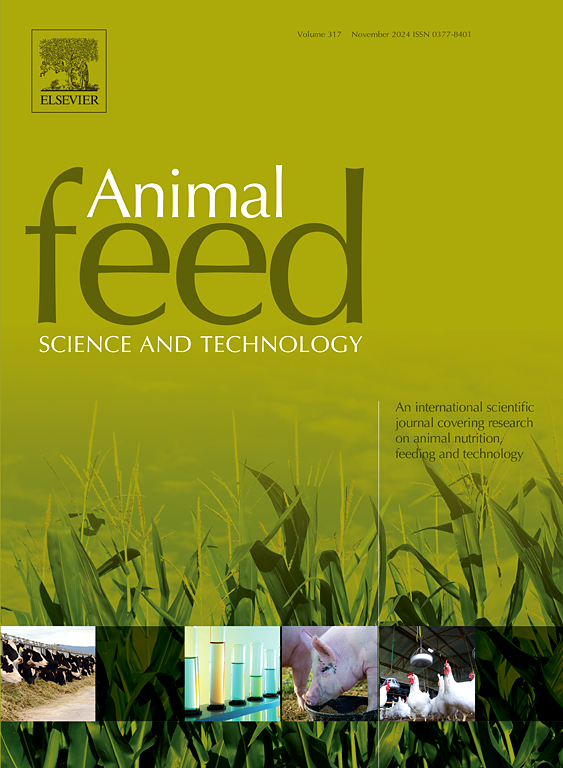Effect of diets with similar nutrient core with increasing starch as filler in growth performance and survival of striped bass (Morone saxatilis) cultured at three different temperatures
IF 2.5
2区 农林科学
Q1 AGRICULTURE, DAIRY & ANIMAL SCIENCE
引用次数: 0
Abstract
The present study aimed to investigate the effects of different diets with similar nutrient core (protein/lipid/micronutrient ratio) but different starch amounts (nutrient core/filler; NC/F) on the productive performance of striped bass (Morone saxatilis) juveniles exposed to different temperatures. Within this purpose, four extruded experimental diets were formulated, decreasing the amount of starch as filler with the same nutrient core with the following protein/lipid/micronutrients (vitamins+choline chloride) (P/L/Mn) ratios: 45.3/11/2.8, 47.3/12.4/3.5, 51.7/13.3/3.7, and 53.3/13.5/4.0 %. Despite the proportions of the nutrient core being the same among diets, the dietary treatments were called according to protein content in the extruded pellet: D45, D47.3, D51.7, and D53.3, respectively. Juveniles of striped bass with an average weight of 7.7 ± 0.24 g were distributed (15 fish per tank) in three recirculating systems (12 tanks each with 500 L water volume). Each system was kept at different temperatures (18, 22, and 26 °C). After eight weeks of the feeding trial, there are clear tendencies after a polynomial regression analysis for growth, feed intake, and hepatosomatic index. However, after a two-way ANOVA analysis considering all temperatures, only feed intake presented an interaction with lower values accordingly at the higher nutrient core. There is no clear tendency at suboptimal temperature, where fish probably survived at basal metabolism. The latter suggests that M. saxatilis mainly depends on the protein/lipid/micronutrient ratio at optimal temperatures to enhance performance.
在三种不同温度下养殖的带鱼(Morone saxatilis),日粮营养成分相似,但填充物淀粉含量增加,对其生长性能和存活率的影响
本研究旨在探讨营养核心(蛋白质/脂质/微量营养素比例)相似但淀粉量(营养核心/填充物;NC/F)不同的日粮对暴露在不同温度下的带鱼(Morone saxatilis)幼鱼生产性能的影响。为此,我们配制了四种挤压试验日粮,在相同营养核心的情况下,减少作为填充物的淀粉量,蛋白质/脂质/微量营养素(维生素+氯化胆碱)(P/L/Mn)比例如下45.3/11/2.8、47.3/12.4/3.5、51.7/13.3/3.7 和 53.3/13.5/4.0%。尽管不同日粮的核心营养成分比例相同,但日粮处理是根据挤压颗粒中的蛋白质含量来划分的:分别为 D45、D47.3、D51.7 和 D53.3。将平均体重为 7.7 ± 0.24 克的带鱼幼鱼(每缸 15 尾)分别放入三个循环系统(12 个水箱,每个水箱容积 500 升)中。每个系统的温度不同(18、22 和 26 °C)。投喂试验进行八周后,经过多项式回归分析,生长、摄食量和肝胆指数都有明显的变化趋势。然而,在对所有温度进行双向方差分析后,只有采食量出现了交互作用,在营养核心温度较高时,数值相应较低。在次优温度下没有明显的趋势,鱼类可能在基础代谢下存活。这表明,在最佳温度下,沙鲈鱼主要依靠蛋白质/脂质/微量营养素的比例来提高生长性能。
本文章由计算机程序翻译,如有差异,请以英文原文为准。
求助全文
约1分钟内获得全文
求助全文
来源期刊

Animal Feed Science and Technology
农林科学-奶制品与动物科学
CiteScore
6.00
自引率
6.20%
发文量
266
审稿时长
3 months
期刊介绍:
Animal Feed Science and Technology is a unique journal publishing scientific papers of international interest focusing on animal feeds and their feeding.
Papers describing research on feed for ruminants and non-ruminants, including poultry, horses, companion animals and aquatic animals, are welcome.
The journal covers the following areas:
Nutritive value of feeds (e.g., assessment, improvement)
Methods of conserving and processing feeds that affect their nutritional value
Agronomic and climatic factors influencing the nutritive value of feeds
Utilization of feeds and the improvement of such
Metabolic, production, reproduction and health responses, as well as potential environmental impacts, of diet inputs and feed technologies (e.g., feeds, feed additives, feed components, mycotoxins)
Mathematical models relating directly to animal-feed interactions
Analytical and experimental methods for feed evaluation
Environmental impacts of feed technologies in animal production.
 求助内容:
求助内容: 应助结果提醒方式:
应助结果提醒方式:


